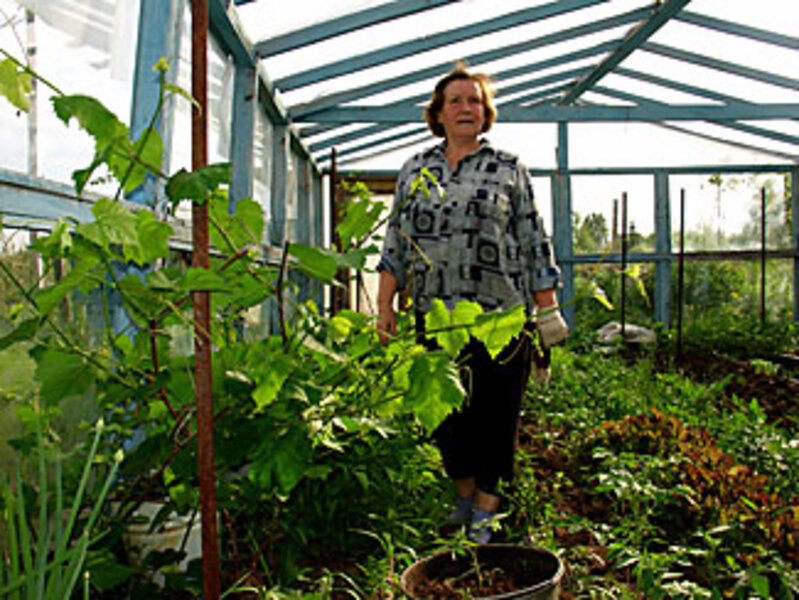Russia's dacha gardens feed body and soul
Loading...
| KRASNOYE, Russia
Lydia Kolbetskaya's tiny farm is a tangle of green shoots, creepers, and bushes. She walks among the plants, proudly naming each one.
"Here are strawberries, there tomatoes, cabbages, cucumbers, garlic...."
The foliage sprawls across her marshy one-acre homestead in this dacha village about 100 miles east of Moscow. Tendrils and leaves crowd against the walls of the little cottage.
The former Moscow defense-plant worker built the dacha from scraps of wood and castoff construction materials after acquiring the place about 15 years ago. Last year, she began work on a greenhouse, where she plans to grow eggplants, grapes, and peppers.
Ms. Kolbetskaya, a pensioner, spends every summer here. Though she says she loves gardening, it's more than just a hobby: She lives on what she coaxes from the reluctant, soggy soil. The produce also helps feed her daughter's family.
"I have to do everything myself, with my own hands," she says. "Sometimes it's hard, but there's no point in complaining. No one will listen anyhow."
Russians have been feeding themselves in this way for a thousand years and, despite the mass urbanization and industrialization of the past century, it's astounding how many still migrate out to their country retreats each summer, lugging shovels, hoes, and other gardening tools (along with kids and babushkas) in their overloaded cars. According to a 2008 survey by the independent Public Opinion Fund in Moscow, a stunning 56 percent of urban Russians possess a dacha or rural "kitchen garden," and one-quarter of all Russian families still rely on home-grown fruits and vegetables for part of what they eat.
Those figures may be more pronounced this year, as a fresh economic crisis sweeps over the country. At least 3 million Russians have lost their jobs since last September, bringing the unemployment rate to above 10 percent. Consumer spending has also plunged.
History suggests that, in times of hardship, Russians take their gardening much more seriously. Amid the crushing post-Soviet collapse almost two decades ago, private garden plots may have saved many families from hunger. Though statistics are hard to come by, an early 1990s study cited by social geographer Sergei Artobolevsky found that 60 percent of the food consumed by residents of two typical small cities, Oryol and Gagarin, originated from dacha and kitchen gardens.
Mr. Artobolevsky says that the relative prosperity of the past decade – known as the "Putin era" – enabled many city dwellers to begin taking vacations abroad and use their dachas more for weekend relaxation. Around bustling centers like Moscow, the once-ubiquitous potato patches virtually disappeared. And in dacha gardens, vegetables gave way to flowers and other decorative plants.
"People began to believe in the wage and consumer economy," he says. "But now, this process has slowed, and no one can say when the crisis will finish."
Sales of vegetable seeds are up 40 percent over last year, potatoes by a whopping 200 percent, says Andrei Tumanov, editor of Vashi 6 Sotok (Your 600 Square Meters), Russia's leading newspaper for serious gardeners. "The more potatoes people grow, the worse things are in Russia," he says. "That's practically a statistical law."
Russia's hidden food power?
The idea of a dacha – a country cottage – is familiar to any reader of Anton Chekhov's stories about 19th-century life in Russia. But it only became a mass phenomenon in the 1970s, when the Soviet authorities began distributing small parcels of land around big cities (typically 600 square meters, or about one-seventh of an acre) as an inducement to urban workers to grow for themselves some of the foodstuffs that the official economy was poor at providing, such as vegetables, herbs, fruits, and berries.
Though the state never published any hard figures, experts say that, by the late Soviet era, as much as 90 percent of the country's fresh vegetables, as well as significant amounts of meat and dairy products, came from "unofficial sources," meaning dacha gardens and the small private plots that collective farmers were permitted to work in their spare time.
"The Soviet leadership had the brilliant idea of handing out plots of land to keep people occupied with feeding themselves," says Mr. Tumanov. "Since then, we've gone through a series of crises in Russia so terrible that, if they'd happened in any Western country, they would have triggered revolution. But not in Russia, because people had their little pieces of land, where they could grow food and keep to themselves. And that system still works."
Threat from Canada?
Kolbetskaya certainly keeps busy tending her garden and puttering about with the endless construction of her little cottage. Though she's chairwoman of her village cooperative this year, she says there's little time for politics. "We would like the government to build a decent road to this place, but local authorities don't seem concerned," she says.
Though it's just a couple hours' drive from Moscow, life in Krasnoye has a remote and timeless quality that tends to blunt political inquiry, she says.
The most exciting development in her patch this year, Kolbetskaya says, is that a Canadian beaver has taken up residence in the tiny creek behind her cottage and has created a minor flooding danger in one part of her garden. (Experts say a silent invasion over the past three decades by Canadian beavers – apparently an aggressive species – has relentlessly displaced the indigenous Russian variety.)
How does she know it's a Canadian one? She points to a solid dam of sticks and mud backing up the creek, and a moundlike wooden lodge. "Our local beavers live in holes in the ground, but the Canadian ones build things. Like me," she smiles.





